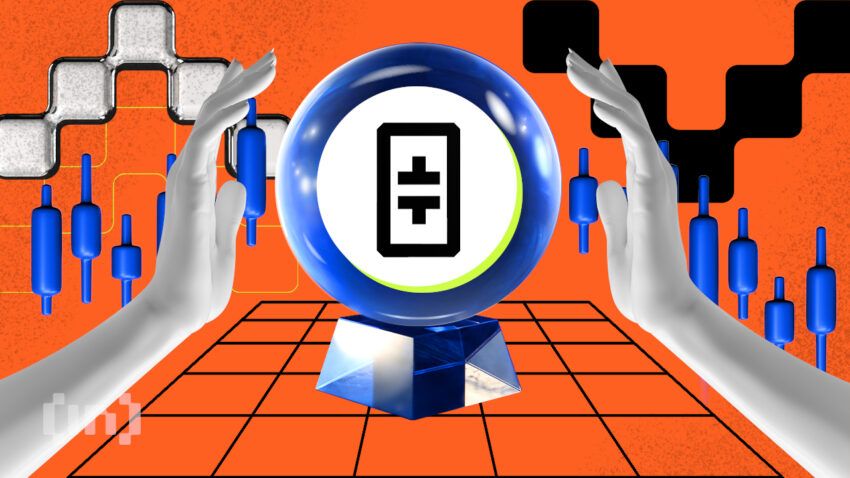Cryptocurrency staking seems to be the new best way to profit from your investments. At the very least, many appear to be profiting from the staking process. That said, staking can only be profitable if you stake in the right project. So, we present to you this list of the top staking coins. Let’s break down the specifics of staking and which projects are the best staking coins for 2024.
- What is staking?
- The advantages of staking
- What to consider when staking cryptocurrency
- Top staking coins for 2024
- Yield farming vs. staking
- Should you stake cryptocurrency?
- What is the best crypto to stake?
- Is crypto staking profitable?
- What is the best wallet for staking?
- Your future in staking
- Frequently asked questions
What is staking?

Staking is the act of locking in or storing cryptocurrencies into their relevant network. By doing so, the staker earns interest based on how much they stake.
While stakers earn interest for their participation, those rewards are provided for a reason. Staking strengthens the security of a network, with users being incentivized with passive income to do this. Those who stake a certain amount become validators, essentially high-priority users that signal to the network they’ll loan themselves to validating transactions.
While staking sounds great, it’s not a ubiquitous way of running a blockchain network. Staking falls under networks that use the proof-of-stake (PoS) consensus algorithm, like Ethereum’s upcoming 2.0 upgrade. This contrasts with the more traditional proof-of-work (PoW) consensus method that, say, Bitcoin uses.
PoW asks users to dedicate their computer power to solving complex algorithms, validating blocks, and earning rewards for doing so. That said, while no consensus method is perfect, PoW suffers from long validation times and also takes up a lot of energy, which isn’t very eco-friendly.
That lack of efficiency is why you’ll see newer blockchain networks shifting to proof-of-stake. Many believe it to be more of a scalable solution for the long term.
The advantages of staking
Compared to proof-of-work, proof-of-stake has various benefits and advantages. For one, nearly anyone can participate. Seeing success as a miner requires expensive hardware, and you’re generally competing against thousands of others who may have better hardware than you.
Proof-of-stake simply asks that you meet the minimum staking requirements.
There’s no investing in additional hardware or charging up your electric bill to try and make a profit. If you have a device and can afford it, profiting from staking is possible.
Plus, the longer you stake, the more you’re guaranteed rewards. It’s an act that generally gives you more of a return the more you commit to it. That’s not to mention the fact that staking is much easier than mining, requiring little technical knowledge to participate properly.
Christopher R. Perkins, President of CoinFund: Coindesk
What to consider when staking cryptocurrency

Before getting into our list of the top staking coins, you must consider a few things.
For one, only stake in a crypto project if you genuinely believe in its mission. Staking generally requires a long-term time and financial investment. If you believe in a project and want to help it grow and improve, that time and financial investment will be much easier to commit to.
Do some research on a project before investing as well. Ensure the team is publicly available to communicate with and that the surrounding community has a positive sentiment toward the mission. Otherwise, investing in a scam that would rather steal your money than watch it grow is possible.
Top staking coins for 2024
Now, let’s get into the top staking coins for 2024.
1. Ethereum

The first token worth staking on this list is ethereum.
What is ethereum?
Ethereum is the world’s second most popular cryptocurrency. It’s also a blockchain-based platform for developers to build and export decentralized applications (DApps).
Why is it on the list?
What’s interesting about Ethereum is it has existed, and still does, as a proof-of-work network. However, the project’s long-awaited upgrade to Ethereum 2.0 is on its way — one that will shift it to a proof-of-stake consensus method.
In preparation for this, anyone can invest in ethereum and choose to stake it on the Ethereum 2.0 network. However, it’s worth noting that this money will be stuck in the network for quite some time — until the 2.0 upgrade launches.
Whether or not you want to wait for that potential launch is up to you. But many users claim it is worth the effort, and while it’s impossible to know for sure, the excitement for Ethereum 2.0 might pay off eventually.
Price
As of this writing, to “pre-stake” on Ethereum 2.0 requires you to stake 32 ethereum via an Ethereum 2.0 node. Considering ethereum has been averaging around $3,000 per, this is quite an expensive request. That said, there are other ways to get involved.
For example, you can stake less than that on Coinbase or some other exchanges. These platforms are essentially delegators, or users you’re funding, to help validate transactions on the new blockchain network.
You can also join a staking pool, which is a big group of stakers all contributing their numbers to total 32 ETH. You’ll earn rewards based on your share of that contribution.
How to stake ethereum
Either stake via an exchange like Coinbase, or you’ll have to run an Ethereum mainnet client and become a node yourself — ideal if you’re looking to stake 32 ETH.
The staking reward
Staking rewards generally vary based on your contribution, platform of choice, and more. That said, experts suggest an average of 5 to 7% returns on a yearly basis.
2. Cardano
After ethereum is cardano (ADA).
What is cardano?
Cardano is a proof-of-stake network often compared to Ethereum, though it differs in various key ways. For example, Cardano, thanks to its Ouroboros proof-of-stake consensus method, can process hundreds of transactions a second. Furthermore, this later project was developed with proof-of-stake as the focus from the start, whereas Ethereum is slowly converting from a proof-of-work project to proof-of-stake.
Plus, Ethereum has dozens, if not hundreds, of decentralized applications releasing on it all the time. Conversely, Cardano has a set of few projects coming to life, due to the blockchain’s very specific, peer-reviewed technology.
Why is it on the list?
As mentioned, Cardano was designed from the start as a proof-of-stake blockchain network. Considering it’s one of the earlier projects to be this way, it’s certainly one worth paying attention to.
Furthermore, staking on Cardano differs greatly from ethereum in that you can pull out staked assets whenever you’d like. Ethereum requires users to wait potentially years before utilizing their staked assets. Cardano has no such limitations, making it much more accessible to users new to the crypto ecosystem.
On top of all this, what’s especially interesting about Cardano is the way it handles staking rewards. If too many people stake ADA in one pool, rewards slowly become less valuable. This incentivizes stakers and to continue creating new staking pools and diversifying their ADA across the network.
Price
Cardano’s price is sitting just under $3 per as of this writing.
How to stake cardano
What’s exciting about this proof-of-stake native blockchain network is that staking is built into the official Cardano wallets, Daedalus and Yoroi.
Because of this integration, staking ADA is incredibly easy for most users, assuming they know how to purchase it on an exchange ahead of time.
The staking reward
Cardano stakers earn an average of 4.5% yearly rewards based on their stake.
3. Tezos

Tezos (XTZ) is the next coin on our list.
/Related
More ArticlesWhat is tezos?
Tezos is a project with a strong focus on governance. While all blockchain networks, including Ethereum and Bitcoin, have some sort of governance method, Tezos’ focus on it is much stronger.
In Tezos’ case, users are consistently proposing new ideas and upgrades to its network. Proposals are then voted in or out based on community feelings, creating a democratic environment for Tezos’ every development.
What’s especially interesting here, however, is that developers are paid for proposals that are accepted. They earn payment by attaching an invoice to their proposal, which is then paid upon approval, hence the community-centric mantra of the project.
Why is it on the list?
Similar to Cardano before it, Tezos was designed with a PoS system in mind from the start. While users can earn interest for staking their XTZ, as is traditional in PoS, holders also get to participate in the aforementioned governance methods. That’s right, the only way to vote on the Tezos network is to stake (or bake, in this case) XTZ.
Of course, by participating in the network, you’re earning rewards for doing so. Tezos incentivizes an active, invested network via these methods.
Price
To become a block baker, one must stake a minimum of 8,000 XTZ.
How to stake tezos
Various exchanges feature support for tezos staking, though you can also get involved via the Tezos website.
The staking reward
Bakers generally earn around 6% in annual rewards via tezos.
4. Polygon

Next up is Polygon (MATIC).
What it Polygon?
Polygon is an attempt at scaling Ethereum. Considering itself as “Ethereum’s Internet of Blockchains,” Polygon exists as a layer-2 protocol that aims to connect all Ethereum-based DApps to ensure they’re all compatible with one another.
With Polygon, transactions between Ethereum blockchains cost less gas and are entirely secured via the network’s validators.
Why is it on the list?
Polygon currently provides the power to validate 65,000 transactions per second within its blocks, ensuring the various Ethereum networks can transact with one another without issue.
It’s a valuable project that only works with validators — those who stake their MATIC and lend their efforts to validating transactions within the network.
Of course, those who stake MATIC also have a say in governance, as is the case with many PoS blockchain networks.
Price
A delegator only needs to stake 1 MATIC to start participating in the network. As for staking, the project requires a minimum of 2 MATIC.
How to stake polygon
Staking MATIC can be confusing if you’re trying to start a node yourself. That said, you can connect what’s called the Polygon Web Wallet to your Metamask wallet. From there, the process of staking your MATIC to earn rewards is quite simple.
The staking reward
Staking rewards vary greatly based on how much you stake and for how long you do so. That said, the web wallet features a calculator to help predict your potential earnings over time.
5. Theta

After Polygon, we have theta (THETA).
What is theta?
Theta is a decentralized video streaming platform aiming to revolutionize the current video streaming experience. As of now, streaming on a website like YouTube requires a ton of bandwidth, and if the network is too congested, users will have an unsatisfactory experience watching content.
Decentralizing video streaming strengthens its infrastructure, as each node contributes some bandwidth to the overall network. This cheapens the overall cost of infrastructure as there’s no one party that has to provide the entire network, which is the case with YouTube.
Why is it on the list?
Advised by a Twitch co-founder and a YouTube co-founder, Theta has a fair amount of legitimate people behind it. The project is made up of three types of nodes — Enterprise Validator Nodes, Guardian Nodes, and Edge Nodes.
- Enterprise validator nodes – Companies such as Sony and Google lend their validating power to the Theta network. The participant must stake 1 million THETA to become an Enterprise Validator Node.
- Guardian nodes – Run by community members, Guardian Nodes double-check the validation efforts made by Enterprise Validator Nodes. These node types act as a mother level of security to the Theta network, stopping any malicious transactions that get past the Enterprise layer. One only needs to stake 1000 THETA to become a Guardian Node.
- Edge nodes – Edge Nodes provide bandwidth to the network, sharing it with all who are viewing content on Theta’s Theta.tv platform. Each Edge Node is streaming a little part of one video, meaning tons of Edge Nodes are streaming different parts of one video, which the end-user can enjoy.
All node types are rewarded for their efforts in the Theta Network’s TFUEL token.
Price
Guardian Nodes require a minimum of 1,000 staked THETA.
How to stake theta
Theta has an official web wallet and a mobile app through which users can try to become a Guardian or Edge node.
The staking reward
Similar to MATIC, Theta nodes’ reward outputs vary based on the amount staked and how long they stake it. A theta-staking calendar can be used to decipher these numbers.
6. Algorand

Algorand (ALGO) is the next one on our list of the best assets for staking.
What is Algorand?
Algorand is a finance-focused project with the goal of solving scalability through instant transactions and validator nodes.
Like Ethereum, Algorand supports various decentralized applications but with lower transaction fees and more transactions per second.
Why is it on the list?
Algorand relies on a PoS consensus algorithm, though a little modified. Here, it’s called a Pure Proof of Stake (PPoS) method, which focuses more on democratization and decentralization.
Essentially, the project only requires a minimum of 1 ALGO for stakers to become validators. This should, in theory, mean there are more validators than other networks. However, the idea can also backfire, as such a small staking minimum could lead to validators who aren’t participating as much.
Price
Only 1 ALGO is required to stake within this project.
How to stake algorand
Interested users can stake using one of the various exchanges like Coinbase, through their Ledger wallets, or via the official Algorand wallet on mobile and web.
The staking reward
While returns depend on your method of staking, know that the official Algorand wallet averages around 5% annual returns.
7. Cosmos

What is cosmos?
Like Polygon, Cosmos intends to be the other “internet of blockchains.” That said, it won’t just focus on Ethereum like Polygon does. Instead, Cosmos aims to make all blockchain networks interoperable.
Why is it on the list?
Cosmos is a proof-of-stake network with validator nodes. The process is pretty standard, requiring users to stake ATOM in order to be considered for transaction validation. The more one stakes, the more likely they’ll be chosen to validate and the more rewards they’ll earn.
Price
To stake cosmos, one must put up a minimum of 0.05 ATOM.
How to stake cosmos
Staking for cosmos is available through many of the exchanges mentioned that support the other projects on this list.
The staking reward
More than most of the other assets on this list, staking earns users, on average, a 9.7% annual return.
8. Polkadot

What is Polkadot?
Polkadot is yet another Ethereum competitor looking to solve the scalability problem suffered by many blockchain networks.
Why is it on the list?
Polkadot requires validators to validate transactions, just like on other PoS platforms. However, it’s worth noting the various differences here compared to other PoS assets.
For one, becoming a validator node on Polkadot is not easy. Setting one up requires some technical knowledge, and becoming a validator also requires a constantly fluctuating amount of DOT.
Sometimes validators need 30 DOT, and other times, it’s 80 DOT to become one. The number is always changing, so it’s hard to describe a reliable one here.
Price
As with the amount of DOT required, the price of said DOT will vary often.
How to stake Polkadot
Ledger, Coinbase, and various other trading platforms have native support for polkadot staking.
The staking reward
While it’s impossible to say for certain due to validator fluctuation, the assumed average annual returns of a polkadot staker is around 14%.
9. ICON
Last but certainly not least on our list is ICON (ICX).
What is ICON?
ICON is yet another project looking to provide interoperability between blockchain networks. It supports hundreds of transactions per second.
Why is it on the list?
ICON utilizes an altered version of the traditional PoS consensus called Byzantine Fault Tolerant Delegated Proof of Stake. Put simply, this means that, at minimum, two-thirds of the network must agree on transactions and such for them to go through. This is a safety mechanism that understands there will always be potentially dangerous nodes and bad actors within the network.
There’s very little chance of those bad actors making up more than two-thirds of the entire network. This way, ICON somewhat ensures that its users are always safe from attack.
Price
Anyone can stake any amount to become an ICON staker and earn rewards. On top of this, stakers must also vote on validators to remain in their staker status.
How to stake ICON
Staking with ICON is pretty easy and possible through various cryptocurrency exchanges, hardware wallets, and the official ICON browser extension wallet.
The staking reward
As of this writing, ICON stakers earn around 16% annually in rewards.
Yield farming vs. staking

Now, if you’ve heard of staking, you’ve likely heard of yield farming as well, considering the two seem quite similar. And while they are similar in some ways, there’s a key difference between the two.
The main difference between these two profit-making methods is the user’s intent when it comes to dedicating their crypto. Yield farming is the act of lending cryptocurrencies to a lending pool, in which others will take loans, and the lender earns interest based on that loan. Staking, however, is the act of locking in cryptocurrencies to participate in the respective network. Both generate profits, but one is riskier than the other.
Yield farming is the riskier one, considering the value of an asset can tumble while you’re lending it. A borrower may be unable to pay back the interest, or a lending pool ends up being a rug pull. You can certainly earn more from yield farming, but that risk is the cost of doing so.
Should you stake cryptocurrency?
After reading all of this, you might still wonder if you should stake cryptocurrency. Well, if one of these projects speaks to you, and you have the means to invest, many would argue staking is a good idea. After all, it’s earning rewards for participating in a network rather than betting on a project’s price, for instance. If you feel comfortable staking and can meet the minimum threshold for doing so, depending on the project, it could be worthwhile to do so.
What is the best crypto to stake?
The best crypto to stake is the one you genuinely believe in, one that you can afford to get involved with, and one that has a return on investment that you can get behind. If you can find a project that matches all of those criteria, finding the top staking coins for you should be no problem.
Is crypto staking profitable?
Generally, yes, crypto staking is considered profitable. This is because one typically earns interest just for holding coins in a wallet. Considering the process doesn’t necessarily require more investment to generate a profit, one could call it profitable.
What is the best wallet for staking?
It’s impossible to decide on the best wallet for staking all cryptocurrencies. That said, if you’re only looking at one or two to get involved with, it’s generally best to stake via the project’s official crypto wallet, assuming they have one. Otherwise, a Ledger or Trezor hardware wallet could be the way.
Your future in staking
Now that you’ve learned all about the top staking coins and some general knowledge about the process, here’s hoping you have a profitable future. Good luck with your investments, and be careful! As you venture into this exciting world, stay informed and diversify your portfolio to maximize your earning potential.
Frequently asked questions
What is staking in crypto?
How does staking work?
What are the benefits and risks of staking?
Which coin will be profitable in future?
Which crypto gives the highest staking?
Can you get rich staking crypto?
How often does staking pay?
Does your crypto grow while staking?
Trusted
Disclaimer
In line with the Trust Project guidelines, the educational content on this website is offered in good faith and for general information purposes only. BeInCrypto prioritizes providing high-quality information, taking the time to research and create informative content for readers. While partners may reward the company with commissions for placements in articles, these commissions do not influence the unbiased, honest, and helpful content creation process. Any action taken by the reader based on this information is strictly at their own risk. Please note that our Terms and Conditions, Privacy Policy, and Disclaimers have been updated.









